
In a post I wrote about over a year ago, I told the story of the “mystery of the stumps” where I described my relationship to the forest where I grew up, the forest to which I belong. I told the tale of a forest with mysterious stumps that my cousins and I couldn’t explain, and later, when I was 14, seeing the loggers come through and was devastated by the experience. I told the tale of the regrowth and healing of that forest as I ventured back in after many years, and the healing lessons that forest provided. And now, there is a new chapter to tell–the healing medicine that the forest produced out of those cut stumps.
This week, I took a trip back to my parent’s house and spent some time in the forest with a good friend. We had recently taken a summer mushroom workshop (which I’ll blog about soon), and we wanted to test out some of our new-found mushroom skills and see what else there was to harvest. When we were there in May, my friend thought that some of the stumps might have the first signs of reishi (Ganoderma tsuga

e) mushrooms, but we needed to look at them later in the season. And sure enough, when we returned, there the reishi mushrooms were, growing beautifully.
We excitedly frolicked through the forest and found them on probably about 15% of the stumps that had been cut down (trees cut about 17 years ago, from when I was around 14). These were hemlock tree stumps, for this is what G. tsugae enjoys growing upon. This experience was more than just finding a great medicinal mushroom–this was a powerful message in healing. These stumps were the trees that were cut, my tree friends that were lost but not forgotten when I was 14. These were the stumps that I couldn’t face, couldn’t enter the forest to see, for at least ten years. And here were the Reishi mushrooms, one of the best medicinal mushrooms in the world, growing there on those cut stumps. It was as if they were saying, “Look! We are fine! We have healed and now we can heal you as well!”
Something shifted in me. This was plant medicine, powerful and meaningful. I already knew that the forest was regrowing, healing from its past injuries. But I hadn’t realized that nature would turn such a tragic occurrence into something magical and medicinal in return. I was and am always astounded by the gifts that nature gives.
Reishi Mushroom Healing: I was first introduced to the Reishi mushroom by my good friend who brewed me some reishi tea with elderberry and honey when I was suffering a very bad head cold. He made me several cups, which I enjoyed and which helped with the cold, and then he sent me on my way with a reishi mushroom tincture. I recovered from the cold quickly, and I’ve had such respect for this mushroom ever since.
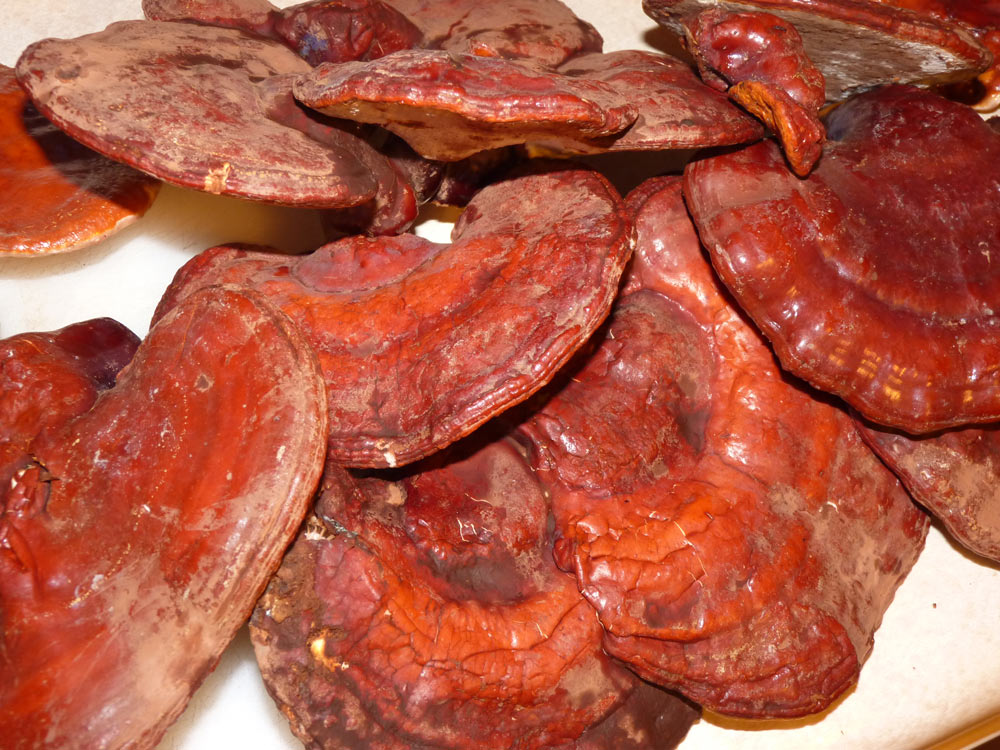
Matthew Wood discusses reishi mushrooms in his Earthwise Herbal: Old World Plants book. He says that the mushrooms contain protein, polysaccharides, phytosterols, and “help reduce autoimmune excess (heat) but also builds up exhausted, cold people, rebuilds the adrenal cortex, regulates blood clotting, and protects the liver” (272). It helps with nervous exhaustion, sympathetic excess, or adrenal burnout, helps with allergies, aids in hypertension by inhibiting cholesterol synthesis, and much more. He suggests that for Reishi to be effective, it has to be cooked for at least an hour and made into a tea or stock with soup bones (273).
Finding and Harvesting Reishi
Reishi mushrooms, specifically the g. tsugae that are native to North America, prefer Hemlock trees–or in my case, hemlock stumps. Matthew Wood suggests that the Asian version of this mushroom, G. lucidum, likes oaks and chestnuts. Another related species that can be found is G. applantum, which grows on Maples. The reishi I found were part of a mesic forest with multiple streams, at the bottom of an Appalachian mountain valley and along the ridges near streams/creeks. This is the same kind of forest where you find ramps, dutchman’s breeches, and wood nettles (we also found healthy amounts of chanterelle mushrooms).
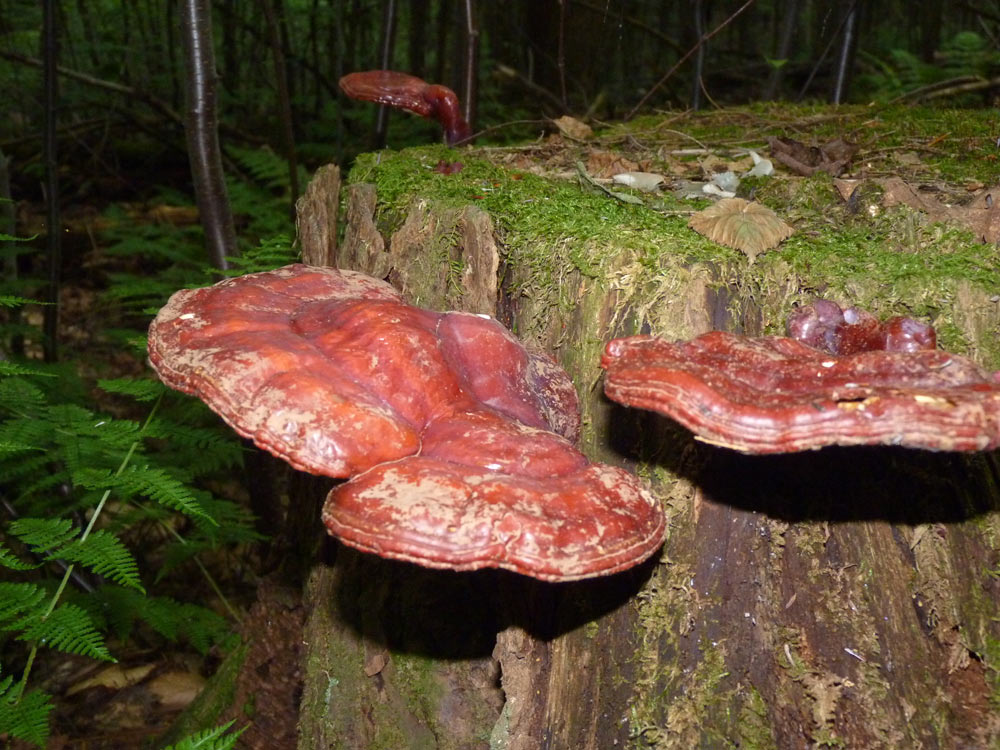
Harvesting of reishi can take place anytime after the mushrooms spore (you don’t want to harvest before they spored because we didn’t want to reduce the population of reishi). After they spore, the fruiting bodies have done their work and you can go ahead and harvest! This will likely happen sometime in July. You want to get them when they are still white on the bottom–about half the reishi or more that we found were past their prime with worms and bugs and stuff in them. We cut out the bad pieces, but its tough work. They get worms, slugs, and such later, which you can cut around, but which doesn’t make a pretty sight (see photo below).

You can harvest reishi with a sharp knife. We used a cloth canvas bag to store our reishi. Here is my friend Paul harvesting reishi–you can note the nice white underside of the mushroom. These ones were a little smaller, but still quite nice.
After you harvest them, you want to clean them (we washed them lightly) and then we cut them up into small slices and dried them in a food dehydrator. Here’s Paul cleaning and cutting the reishi.
After about 12 hours, the reishi are dry, and you can store them in a mason jar with a tight lid till they are needed. What a wonderful mushroom!

So I will take this as a medicinal mushroom, in tea and in tinctures (I will be providing a post on how to make a double-extracted reishi tincture in the future at some point!) It will always remind me of the healing power of nature, the importance of the cycle of life, and is a reminder of the blessings that nature provides. I hope that you, too, readers, will have the experience of harvesting and honoring this wonderful medicinal mushroom. If you want to learn how to make a double-extracted tincture from these–check out this post.
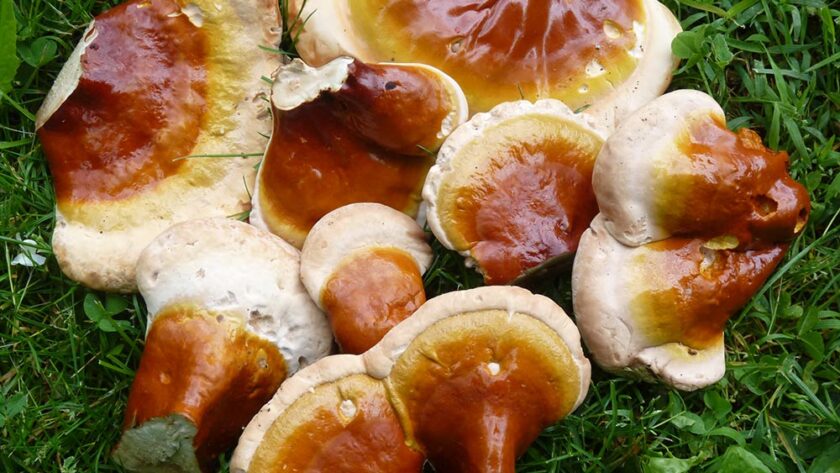

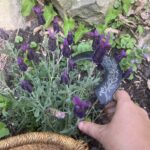
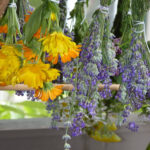
Thank you for the interesting and informative article. Living here in New England I see a lot of these (we call them ‘wood mushrooms’ because that is what they usually are by the time they are found…equivalent to a piece of wood) but never realized they had anything but a decorative function…I’ve seen folks who take the dried ones and paint scenes on them for sale to the ‘city slickers’. By any chance is there a stage at which they have a culinary use, or is it a catch-as-catch-can on their edibility?
OwlOak, the decorative mushrooms that people paint on are also medicinal. I don’t think they make very good eats, but their medicinal qualities are quite good :).
Very nice…….I pick and use these myself. We share a friend in relationship…….. indeed. I know and interact with quite a few others as well. Good work man!
Thanks for the comment :). Do I know you through someone else? (I’m a woman by the way… :P)
Thank you for the article 🙂
Hi Cody, you are most welcome!
Wilowcrow, I just came across some nice reishi today. The varnished appearance is gone but the mushroom is still very sturdy and not at all rotted. Can the mushroom be sliced and dried an used as a medicinal tea in this condition? Jim
Sorry about that Willowcrow………….my reference to “friend” in the comment above is the mushroom we are calling reishi. I know a few more here in North Western PA to.
Reishi are certainly friends! 🙂
Hi I am very interested in looking for this mushroom. I’m in eastern mi. Do you know closer locations to me I could find these mushrooms? My fiance has fibromyalgia and we’ve been reading up for medicinal proposes and most of his side effects of fibro this mushroom can help with. Please any info would help! Thank you!
They grown primarily on Hemlocks. I’ve seen hemlocks in forest around the Port Huron region (like state lands, etc). You’d want to look for a site that has a good amount of dead wood, etc.
Alternatively, you can get them online through Mountain Rose Herbs: https://www.mountainroseherbs.com/search?page=1&q=reishi&utf8=%E2%9C%93
Reblogged this on Laura Bruno's Blog and commented:
I found this 2013 post after reading Willowcrow’s latest post about wild violets, of which we have plenty! https://druidgarden.wordpress.com/2015/05/11/wild-food-recipes-maple-candied-violets-and-honeyed-violets/
I expected to find information on growing or using Reishi, but the story connected to this post is such an encouraging and profound example of Earth healing that I felt it needed a repost. Well worth a contemplative read, and you’ll learn something about Reishi mushrooms, too. 🙂
Thanks for the reblog, Laura! 🙂
🙂
Question: I purchased some recently and when I cut it up, found some small white… Worms? Or tiny bugs. Is it safe to use this still?
I would still use them :). Worms are common in a lot of wild mushrooms! Unless you think the worm infestation happened after they were dried–that’s a bit of a different story.
I should add that the kinds of worms I found in reishi in the woods were as follows:
1) Slugs like them, so slugs (not really worms)
2) I found little greyish, fat worms (not maggots, but darker) that burrowed in. They seem to only burrow into much older reishi. The younger ones are eaten by slugs.
I hope this helps 🙂
Hi! Do you know how long the reishi mushrooms last in the jar after being dried?
Most dried herbs and mushrooms, when stored properly, can last up to 1-2 years. Proper storage means cool, dry, out of light. Personally, I would recommend double extracting them once you harvest them or buy them to preserve the most medicinal value. You can find out how to do that here: https://druidgarden.wordpress.com/2015/08/08/making-a-reishiganoderma-mushroom-double-extract-tincturet/
Well, read more here http://chagaherb.com/dried-reishi-mushrooms-review/
Thanks for the info! 🙂
Hello,my name is David
Due you sell any of the reishi you harvest or have any recommendations on where im able to purchase sustainable wild harvested reishi? Thanks for your time, in advance.
Hi David, I don’t sell any of the plants or mushrooms I harvest–they are for personal use only. However, there are several ethical herbal companies that do–you might look at Mountain Rose Herbs (as one of the largest) who carries information on their sources and locations of herbs, etc. Blessings and best of luck in your search 🙂
I made my g.tsugau reishi tincture with vodka min 40% proof. Sliced and dried I poured the vodka over them in a jar shake daily if poss over 2-6 weeks or longer if just storing. After this remove reishi and squeeze alcohol out.. lets say you have a litre of alcohol out of them. Then take the pieces and boil in water for 10 mins and simmer for up to 20mins to 3 hours.. when strained andleft with a litre of water then mix the litre of alchol with the litre of tea and you will have your reishi tincture 25% depending on the strength of the alcohol. Thats it.. take 3-5 drops daily.. or just drink the tea or the alchol seperately. But the alcohol extracts the anti cancer properties from thd skin and the tea extracts the rest. When making tea you can reuse the same reishi until no colour is left. Better to take in the ecening as relaxing. I took it as I have R.A. as well as arthertis and has helped me enormously. If anyone knows how I can collect my spores and what cheap way I can crack the spores to make reishi oil please ket me know. Or how to store uncracked spores
Thanks for the information!
[…] Now to really experience the power of this ancient ally to the Taoist, I recommend trying to find them in the wild. Normally, I would NEVER recommend this. However, because there are no poisonous mushrooms that even remotely resemble Reishi, I will. Look up images online and wander out into the woodlands. The ones we look for tend to grow on hemlock, either the stumps or the logs. Gather them when they are in full color and the more vibrantly colored the more potent. This is usually mid to late summer. For an excellent guide to finding and harvesting here is a link: https://druidgarden.wordpress.com/2013/08/02/wild-medicinal-plant-profile-reishi-mushrooms-ganoderma… […]
Thanks for the link!
I found A LOT of worms in Ganoderma growing in standing dying maple here in Indiana. The worms are actually really tasty! (And I have added this to my foraging acuity) If you like really shroomy tasting stuff. I wonder if anyone has researched this or has any other personal experiences with this. I cant even find out what this insect larva is categorized as.
An Entomology geek is desired.
This is the only way to eat Reishi. And I am stoked.
Hi Nicholas, great! I wonder if its the larvae of Bolitotherus cornutus? It might be in your region. If not that, I have no idea! But I’ve seen them here in PA on lots of ganoderma tsugae.
To add to my last message, be careful eating these. Ganodermas do have side effects that are unpleasant(not dangerous) if used in excess. And I believe that I have made myself sick from whatever has become concentrated in the larva from their exclusive diet of this fungus.
Good to know!